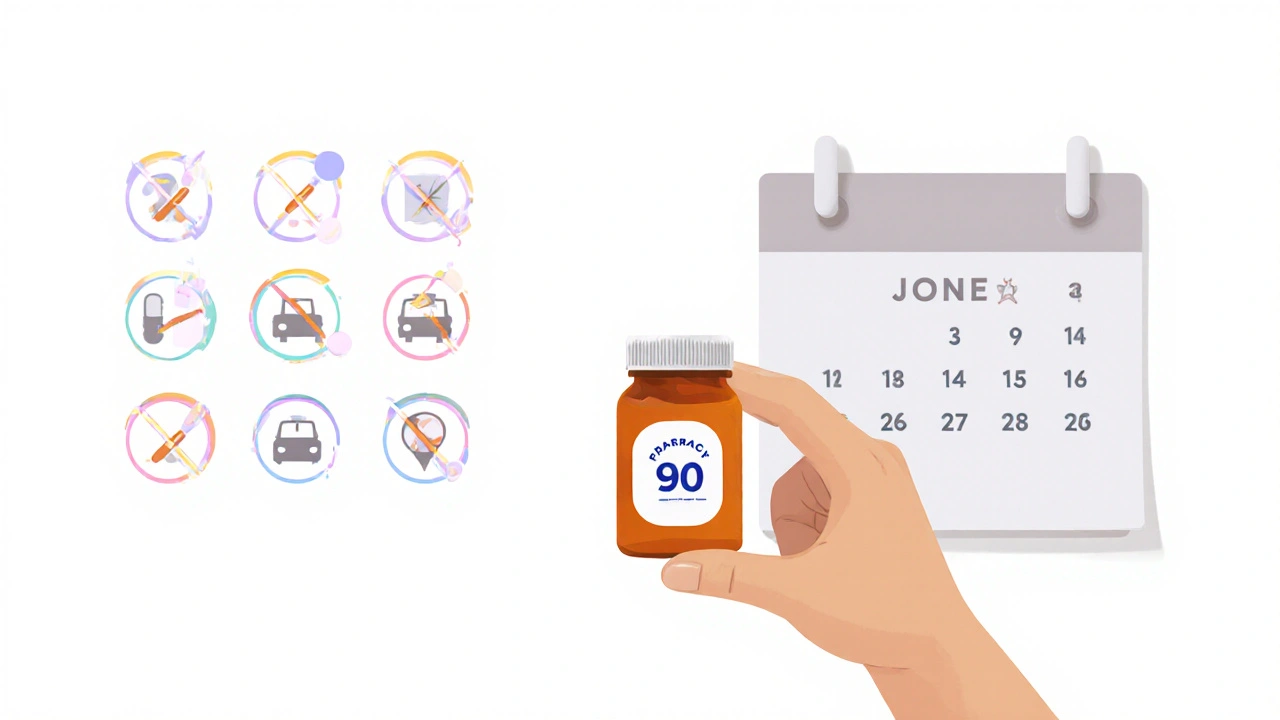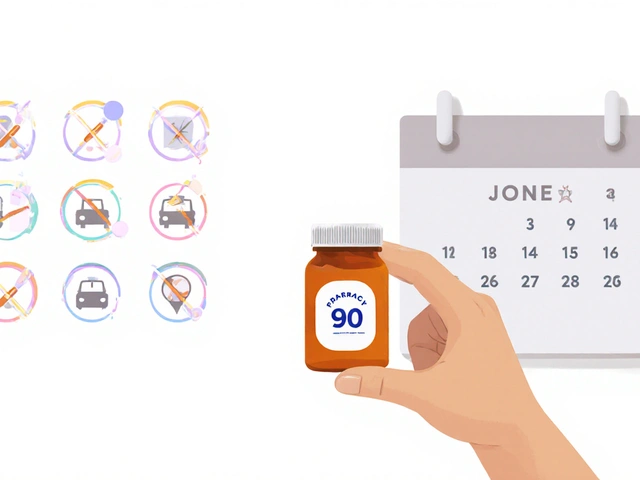Why 90-Day Prescriptions Save Time, Money, and Stress
If you take medication every day for a chronic condition-like high blood pressure, diabetes, or cholesterol-you know the routine: drive to the pharmacy, wait in line, hand over your prescription, pick up a 30-day supply, and do it all again in a month. That’s 12 trips a year. Just for one pill. Imagine cutting that to three. That’s the power of a 90-day supply.
It’s not just about fewer trips. Studies show people who get 90-day fills are 27% more likely to take their meds as prescribed. That means fewer hospital visits, fewer complications, and better health over time. You also save money. On average, people pay $2.35 less per month per prescription with a 90-day supply. That adds up to over $28 a year per medication. For someone on three or four meds? That’s more than $80 saved annually.
And it’s not magic. It’s a benefit built into most insurance plans-Medicare Part D, Medicaid, and private insurers like Aetna, Cigna, and CVS Caremark. But you have to ask for it. No one’s going to offer it unless you bring it up.
Which Medications Qualify for a 90-Day Supply?
Not every prescription can be filled for 90 days. These programs are designed for maintenance medications-drugs you take daily for long-term conditions. Think:
- High blood pressure (lisinopril, amlodipine)
- Diabetes (metformin, glimepiride)
- Cholesterol (atorvastatin, simvastatin)
- Thyroid (levothyroxine)
- Depression or anxiety (sertraline, escitalopram)
Medications that won’t qualify:
- Antibiotics
- Painkillers (like oxycodone or tramadol)
- Short-term steroids
- Insulin (usually limited to 30-day fills due to stability concerns)
- Specialty drugs (like those for MS or rheumatoid arthritis)-often require three 30-day fills before you can switch to 90 days
Your pharmacist or insurance plan’s website will list which drugs are eligible. If you’re unsure, just ask: “Is my medication on the 90-day list?”
How to Get Your Doctor to Write a 90-Day Prescription
The biggest roadblock? Doctors often default to 30-day scripts. They’re used to it. They might not even know you’re interested in switching. So you need to lead the conversation.
Here’s exactly what to say at your next appointment:
- “I’ve been taking my [medication name] every day without missing a dose.”
- “I’d like to switch to a 90-day supply to cut down on pharmacy trips.”
- “Is that something you can prescribe?”
That’s it. Simple. Direct. No jargon. You’re not asking for a favor-you’re using a benefit you’re already paying for.
If your doctor says no, ask why. Common excuses:
- “We usually do 30-day fills.” → Respond: “I understand, but my plan allows 90-day. Can you check if it’s approved for this drug?”
- “I need to monitor your labs first.” → Say: “I’m happy to get bloodwork done. Can we still switch once results are in?”
- “I’m not sure about the dosage.” → Reply: “I’ve been stable on this dose for [X months]. Can we try 90 days?”
Most doctors will say yes once you show you’re responsible. Bring up your adherence. Mention cost savings. It’s not pushy-it’s smart.

How to Fill Your 90-Day Prescription: Mail vs. Retail
Once your doctor writes the script, you have two main ways to get it:
Option 1: Mail-Order Pharmacy (Best for Convenience)
Most insurers partner with mail-order pharmacies like CVS Caremark, Express Scripts, or Cigna 90 NowSM. You sign up online, enter your prescription details, and they ship your 90-day supply to your door.
Pros:
- No driving, no waiting
- Automatic refills (they’ll remind you when it’s time)
- Often cheaper copays
- Free shipping
Cons:
- Takes 7-10 business days to arrive
- Can’t get it same-day if you run out
How to start: Log into your insurance portal (like myCigna.com or Caremark.com), go to “Prescriptions,” and select “Start Rx Delivery by Mail.” Then enter your doctor’s info. They’ll contact your doctor if needed.
Option 2: Retail Pharmacy (Best for Immediate Access)
Some plans let you get 90-day fills at select retail pharmacies like Walmart, Kroger, or Walgreens. Walmart, for example, offers generics at $10 for 90 days.
Pros:
- Get it same day
- No shipping wait
- Easy to pick up if you’re already shopping
Cons:
- Only available at specific stores in your plan’s network
- Not all drugs qualify
- May require you to pay upfront and submit for reimbursement
Check your plan’s website for a list of network pharmacies that offer 90-day fills. Call ahead: “Do you fill 90-day prescriptions for [medication]?”
What to Do If Your Plan Doesn’t Offer 90-Day Fills
Not all plans do. Especially if you’re on Medicaid or live in certain states like California, Texas, or Minnesota, 90-day options might be limited.
Still, don’t give up. Here’s what to do:
- Call your insurance customer service. Ask: “Do you offer 90-day supply for maintenance medications under my plan?”
- If they say no, ask: “Can I switch to a different plan during open enrollment?”
- Check if your plan has a mail-order pharmacy-even if it’s not labeled as 90-day, some let you request a 3-month supply with a special request form.
- For Medicare Advantage members: You might be eligible for 100-day supplies. Ask specifically about that.
If your plan truly doesn’t offer it, talk to your doctor about switching to a medication that does. Sometimes, there’s a generic alternative that’s covered under 90-day programs.

Common Problems and How to Fix Them
Even when you do everything right, things can go wrong. Here’s how to handle the most common issues:
Problem: My pharmacy says “I can’t fill this for 90 days.”
Ask them to check your plan’s rules. Sometimes the system locks the script because it’s coded as 30-day. Your pharmacist can override it if your insurance approves.
Problem: I got a 30-day refill by accident.
Call your insurance. Say: “I was approved for 90-day supply, but I only got 30 days. Can you fix this?” They can often reprocess the claim.
Problem: My medication is too expensive even with 90-day.
Ask your doctor about switching to a generic. Walmart’s generic 90-day prices are often $10 or less. You can also use GoodRx or SingleCare coupons at any pharmacy.
Problem: I need my meds right now, but mail-order takes 10 days.
Fill a 30-day at your local pharmacy while you wait for your mail order to arrive. Then switch over.
How to Stay on Track Once You Start
Getting a 90-day supply is great-but it’s useless if you forget to refill. Here’s how to make it stick:
- Set phone reminders for when your refill is due (not when you’re running out).
- Sign up for refill alerts from your mail-order pharmacy.
- Keep a printed list of all your meds and their refill dates on your fridge.
- Use a pill organizer with a 90-day layout-many come with weekly and monthly compartments.
Also, review your meds every 6 months. If you’ve stopped taking one, tell your doctor. Don’t keep getting refills for pills you don’t need. That’s wasted money and clutter.
What’s Next? Making This a Habit
Once you’ve done it once, it gets easier. Next time you see your doctor, say: “Can we make all my maintenance meds 90-day?” Most people have 3-5 of them. Doing this for all of them cuts your pharmacy trips from 60 a year to 15. That’s 45 hours saved. Time you could spend with family, at work, or just resting.
And the health benefits? They’re real. People who stick with 90-day refills have fewer ER visits, fewer hospital stays, and better control of their conditions. It’s not just about convenience-it’s about living better.
Start today. Pick one medication. Call your doctor. Ask for 90 days. You’ve got nothing to lose-and months of your time to gain.
Can I get a 90-day supply of my blood pressure medication?
Yes, most blood pressure medications like lisinopril, amlodipine, and hydrochlorothiazide are eligible for 90-day supplies. These are considered maintenance drugs for chronic conditions. Check your insurance plan’s formulary or ask your pharmacist to confirm eligibility.
Do I need a new prescription for a 90-day supply?
Yes. Your doctor must write a new prescription specifically for 90 days. A 30-day script cannot be extended or refilled for 90 days without a new order. Ask your doctor to indicate “90-day supply” or “3-month supply” on the prescription.
Is a 90-day supply cheaper than three 30-day fills?
Usually yes. Most insurance plans offer lower copays for 90-day supplies. For example, a 30-day generic might cost $15, so three fills would be $45. A 90-day supply often costs $25-$30. That’s a savings of $15-$20 per refill cycle. Some plans, like Walmart’s, charge just $10 for 90 days on generics.
Can I switch from mail-order back to retail if I need to?
Yes. You can switch between mail-order and retail pharmacies at any time. If you need a medication quickly, get a 30-day fill at a local pharmacy. Then resume your 90-day mail-order refill when you’re ready. Just make sure your insurance still covers the switch-some plans require you to use their network pharmacies.
Are there states where 90-day supplies aren’t available?
Yes. Some states have laws that limit extended supply programs. As of 2025, California, Minnesota, New Hampshire, Texas, and Washington have restrictions on certain mail-order or 90-day prescription programs, especially for Medicaid recipients. Check with your insurer or state health department for details.


